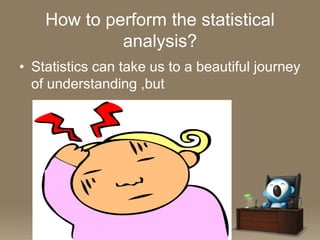Introduction to statistics
- 1. Introduction to statistics By Dr. Amira Talic
- 2. What is “Statistics”? • • • • • • •Statistics is the science of data that involves: •Collecting •Classifying •Summarizing •Organizing and •Interpretation • • • • • • • Of numerical information. •Examples: •Cricket batting averages •Stock price •Climatology data such as rainfall amounts, average temperatures •Marketing information •Gambling?
- 3. Key Terms • What is Data? facts or information that is relevant or appropriate to a decision maker • Population? •the totality of objects under consideration • Sample? •a portion of the population that is selected for analysis
- 4. Key Terms • Parameter? a summary measure (e.g., mean) that is computed to describe a characteristic of the population • Statistic? a summary measure (e.g., mean) that is computed to describe a characteristic of the sample
- 5. Variables • Traits or characteristics that can change values from case to case. • A variable is what is measured or manipulated in an experiment •Examples: •Age •Gender •Income •Social class
- 6. Types Of Variables • In causal relationships: • CAUSE =>EFFECT independent variable & dependent variable •Independent variable: is a variable that can be controlled or manipulated. An independent variable is the variable you have control over (dose of drug) •Dependent variable: is a variable that cannot be controlled or manipulated. Its values are predicted from the independent variable ( effect on the condition)
- 7. Types Of Variables •Discrete variables are measured in units that cannot be subdivided. Example: Number of children •Continuous variables are measured in a unit that can be subdivided infinitely. Example: Height
- 8. Statistical analysis • Descriptive Statistics • Inferential statistics • Predictive modeling
- 9. Descriptive Statistics •Gives us the overall picture about data •Presents data in the form of tables, charts and graphs •Includes summary data •Avoids inferences Examples: •Measures of central location Mean, median, mode and midrange •Measures of Variation •Variance, Standard Deviation, z-scores
- 10. Inferential Statistics •Take decision on overall population using a sample • “Sampled” data are incomplete but can still be representative of the population •Permits the making of generalizations (inferences) about the data • Probability theory is a major tool used to analyze sampled data
- 11. Predictive Modeling • The science of predicting future outcomes based on historical events. • Model Building: “Developing set of equations or mathematical formulation to forecast future behaviors based on current or historical data.” • Regression, logistic Regression, time series analysis etc.,
- 12. Calculation of the probability • Based on the characteristics of the population for the observed parameter • (e.g. . Duration of the pregnancy, duration of the first labor stage, height, et cetera) • To describe the population, “distribution” will be used
- 13. Distribution • A statistical distribution describes the numbers of times each possible outcome occurs in a sample • Distributions for continuous variables are called continuous distributions ( e.g. height) • They also carry the fancier name probability density
- 14. Distribution • Some probability densities have particular importance in statistics. A very important one is shaped like a bell, and called the normal ( Gaussian) distribution. • Many naturally-occurring phenomena can be approximated surprisingly well by this distribution. It will serve to illustrate some features of all continuous distributions.
- 16. What are the Components of A Distribution? • Measures of central tendency • Suppose we have a sample with 4 observations: 4, 1, 4, 3 • Mean = the sum of a set of numbers divided by the number of observations (4+1+4+3=12:4=3) Median - the middle point of a set of numbers(3.5)
- 17. Components of distribution • Mode - the most frequently occurring number. Mode=4 • Median - the middle point of a set of numbers(3.5)
- 18. Components of distribution Measures of variation Range - the maximum value minus the minimum value in a set of numbers. Range = 4-1 = 3 Standard Deviation - the average distance a data point is away from the mean. [ (4- 3)+( 1 -3)+ (4- 3)+ (3- 3)]: 4=1 standard deviation= 1
- 20. Why to know about it ? • Mean, Median, Mode, Range, and Standard Deviations are measurements in a sample (statistics) and can also be used to make inferences on a population.
- 21. What do we expect from the statistical analysis? • To find out whether there is a statistically significant difference between our sample (e.g. pregnancy loss in Al Ain Hospital Patient) and general population
- 22. How to perform the statistical analysis? • Statistics can take us to a beautiful journey of understanding ,but
- 23. Festina lente! make haste slowly



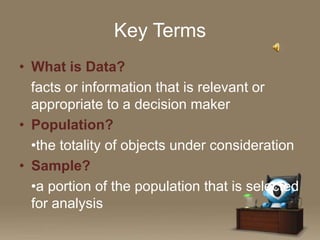

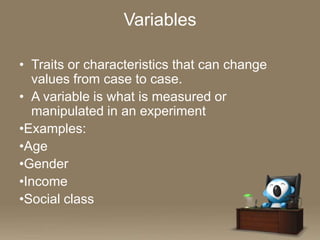
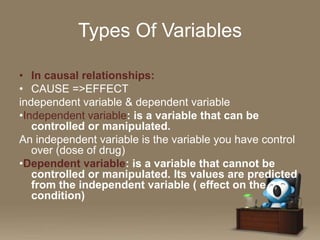





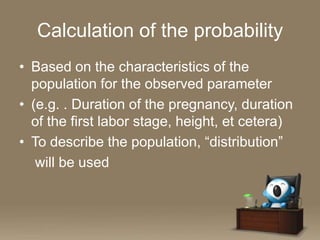



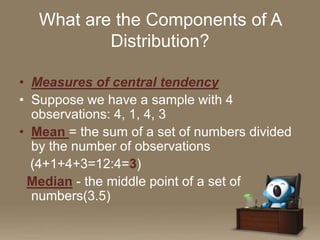

![Components of distribution
Measures of variation
Range - the maximum value minus the
minimum value in a set of numbers.
Range = 4-1 = 3
Standard Deviation - the average
distance a data point is away from the
mean.
[ (4- 3)+( 1 -3)+ (4- 3)+ (3- 3)]: 4=1
standard deviation= 1](https://izqule7twkl7vq3ljkxejyz-s-a2157.bj.tsgdht.cn/introductiontostatistics-131111162230-phpapp02/85/Introduction-to-statistics-18-320.jpg)



